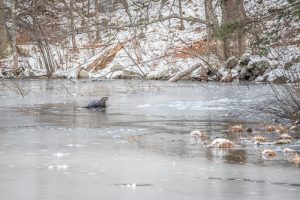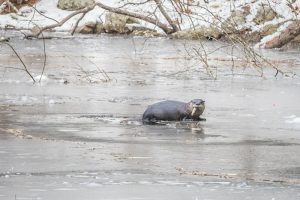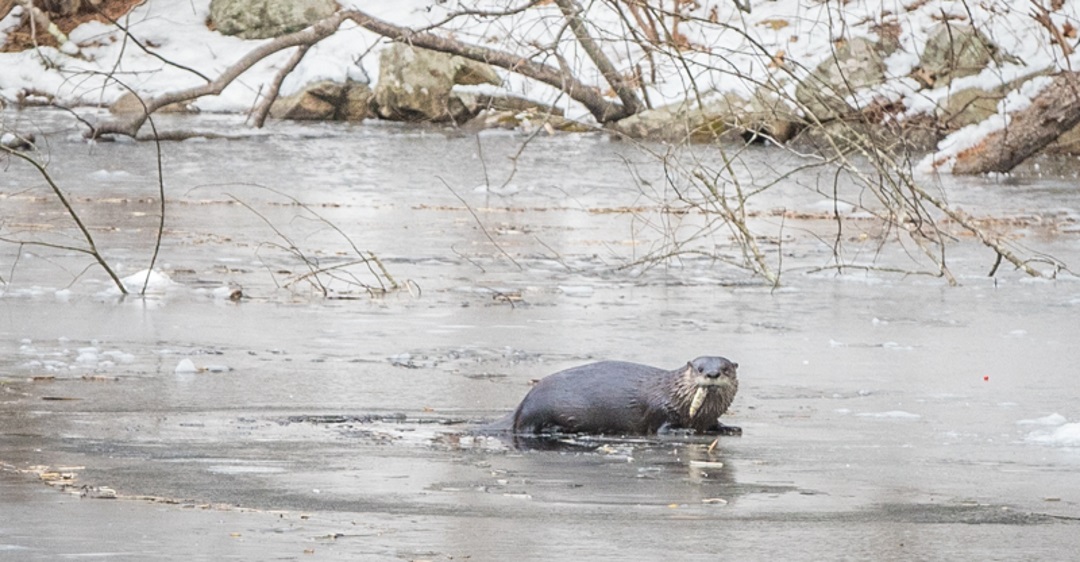Water Closet for January 12, 2018
[pullquote]”Otters eat perch, catfish, crayfish, minnows, turtles, snakes and even lamprey eels. In their quests for food and in play otters surface about every 30 seconds for air.”[/pullquote]What common local mammal is shiny, black and graceful with long white whiskers? He and she are also playful and like to eat fish. They may be better swimmers than their prey with fins. If you haven’t guessed by now you otter try again. Recently Stream Team photographer Judy Schneider visited Prichards Pond, a third mile long swelling in Boston Brook created by the late Charles Prichard’s century old dam. She spotted an otter near a hole in the ice eating a fish. As she watched the next half hour in the cold, the fish eater went down five times and each time soon returned with a fish it promptly ate. Leah Moreschi a neighbor just up the street says those going to and from work as she does daily often see otters on Prichard’s Pond. Last winter Stream Team President Sandy Rubchinuk and the old Closeteer found a recently deceased male near the bank down by the dam. They speculated that wind storms the night before might have loosed a branch that struck its head. The excited finders then thought in 19th century ways and took the corpse to a taxidermist nearby and told him it would be the Middleton Stream’s mascot when stuffed. A mounted otter was not delivered as agreed. Sandy and the Closeteer have since come to their senses so didn’t push. They’d seen too many stuffed birds and mammals gathering dust in people’s houses and museums. Cheap photography, now available to all has rendered them something for only scholars and game hunters wanting 3D records of their victims. President Teddy Roosevelt, taxidermist as a lad, had popularized the skill more than a century ago. Stuffed animals have been going the way of zoos in the last half century. We can now enjoy wildlife alive on TV without being there. The Stream Team’s crackerjack photographers share their fine photos all the time.

Otters maintain openings in the ice for access to their prey. They move water body to water body over large ranges around our towns. – Judy Schneider photo
A few days after receiving Judy Schneider’s photos of otter at icy-table the Middleton COA/CC Friday hikers went forth two miles northeast of Prichard’s Pond on the thickening ice of Crooked Pond in Boxford State Forest. In 10 degrees F air the ten hikers age nine to 85 found many mammal tracks crisscrossing the pond which is twice the size it was two decades ago due to the yearly higher beaver dam at the pond’s eastern outlet. The outlet stream below the dam leads to Fish Brook then on to the Ipswich River. December was a dry month so the pond level is still down two feet below the top of the dam. The tracks included those of deer, coyote, fox, beaver, and two big weasels, fisher and otter. The latter’s trails were clearly seen by their slides up to 20 feet long, then 5 toed footprints with claws followed by another slide resembling a kid’s narrow toboggan. Between the track a dragging tail line was clearly seen. Fisher with similar foot prints don’t slide and their light tails don’t make distinct lines. At one point in the white ice a window pane of thin black ice was found about two feet in diameter. The old Closeteer lay down face to ice and played Peeping Tom. Nothing was seen in the clear water. He thought this an otter access hole when kept open. Beavers keep such openings at dams and entrances at the base of their lodges. Three lodges were seen on Crooked Pond. It must be a great chore to keep openings in days of 0 degree F weather such as we had in the two weeks spanning Christmas and New Year’s Day.

River otter eats one of many fish caught recently in Prichard Pond, Middleton. These dark brown members of the weasel family with dense soft hair have long white sensitive whiskers. – Judy Schneider photo
Beavers stay in their ponds. Otters are frequently on the move. Females half the size of males have ranges which they rove with young of about 10 square miles. Males’ ranges are closer to 60 square miles, four times the size of small Middleton. Both sexes beeline pond to pond every few days on their rounds. Fishers on the other hand zig zag place to place on dry land. This is an easy way to tell their track patterns apart. Otters eat perch, catfish, crayfish, minnows, turtles, snakes and even lamprey eels. In their quests for food and in play otters surface about every 30 seconds for air.
It is interesting to know that these 10 to 30-pound common mammals are roaming water body to water body mostly unseen by humans. They must travel a lot by night. We usually only see them in the water. If you see several together they are probably mother with two to four young. Males are largely kept away except when the female is in heat. Otters prefer places where water enters and leaves ponds. Prichard Pond has two convergences where pond and stream waters mix to form a rich mix of nutrients for organisms. Judy’s photos were taken from Mundy Bridge where Boston Brook and Pond Meadow Brook enter. Boston Brook comes down from Holt and Boston Hills, North Andover, and Pond Meadow Brook starts up in Boxford. So in relatively small Middleton alone we’ve seen otters or their signs almost every year in Prichard’s Pond, Tragert’s Pond, Creighton Pond, Boston Brook, Pond Meadow Pond, Webber’s Pond, Emerson Bog, Mill Pond, Middleton Pond, Nichols Brook and the Ipswich River. They like clean water but nearby houses don’t seem to bother. These water bodies are all within otter ranges; however, males mark their territories with scat and scent spots that don’t often overlap. We often find their scat which consists largely of undigested fish scales.
These facts listed above are largely from naturalists, trappers, and wildlife researchers. Our favorite sources for mammals in the Water Closet library of our hidden, floating headquarters moored along the Ipswich River are Paul Rezendes’ Tracking and the Art of Seeing and naturalist husband and wife team Paul and Lillian Stokes’ book Animal Tracking and Behavior. We don’t loan them, you’ll have to get your own references. However, it’s better to get out there and follow tracks on your own or visit water body edges on foot or in kayak. As Harvard’s famous 19th century naturalist Louis Agassiz urged in a slogan painted on his lab’s wall: “Study Nature Not Books.” The Stream Team urges you to do both, the former first. After all it was Judy’s shared observations that led us to this review and book research.
__________________________________________________________
WATER RESOURCE AND CONSERVATION INFORMATION
FOR MIDDLETON, BOXFORD AND TOPSFIELD
| Precipitation Data* for Month of: | Sept | Oct | Nov | Dec | |
| 30 Year Normal (1981 – 2010) Inches | 3.77 | 4.44 | 4.55 | 4.12 | |
| 2017 Central Watershed Actual | 2.44 | 4.03 | 1.54 | 1.9 | |
Ipswich R. Flow Rate (S. Middleton USGS Gage) in Cubic Feet/ Second (CFS):
For Dec 21, 2017 Normal . . . 52 CFS Current Rate . . .17 CFS
——————————————————————
*Danvers Water Filtration Plant, Lake Street, Middleton is the source for actual precipitation data thru Nov.
** Middleton Stream Team is the source of actual precipitation data for Dec.
Normals data is from the National Climatic Data Center.
THE WATER CLOSET is provided by the Middleton Stream Team: www.middletonstreamteam.org or <MSTMiddletonMA@gmail.com>


melon99 hello my website is melon99
jpnatio hello my website is jpnatio
busur4d hello my website is busur4d
depxito hello my website is depxito
kode sdy hello my website is kode sdy
sloto99 hello my website is sloto99
stretch hello my website is stretch
rvn1015 hello my website is rvn1015
jsvmp hello my website is jsvmp